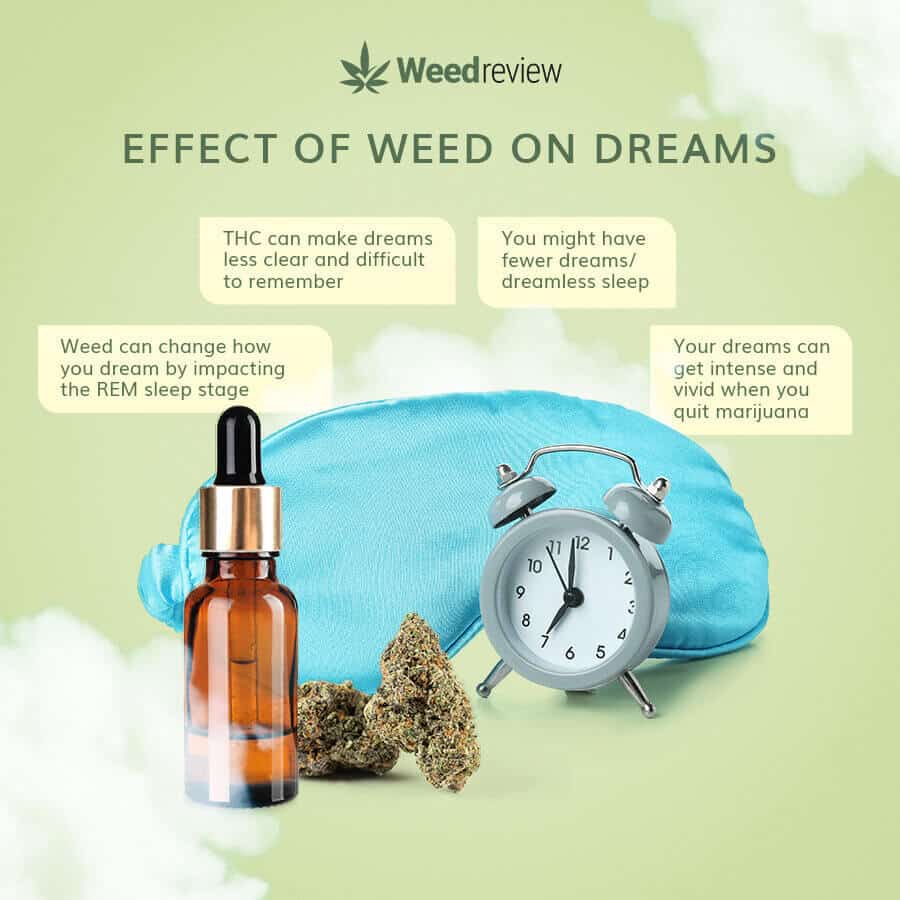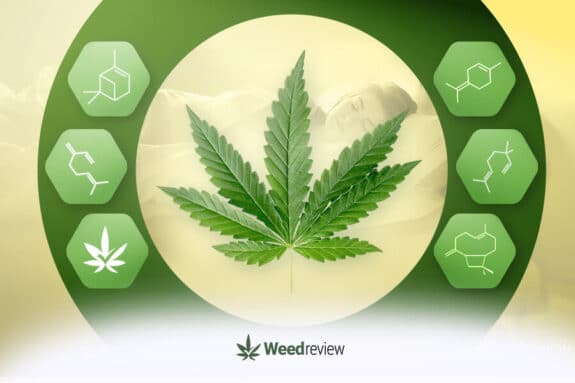
Cannabis & Dreams: Impact on REM Sleep, Therapeutic Potential, Intense Dreams

Table of Contents
Dreams give a glimpse into the depths of our minds. Cannabis has gathered the curiosity of researchers and cannabis fans alike when it comes to its impact on dreams.
While many people use medical cannabis for sleep, they observe an evident difference in their dreaming patterns.
Marijuana seems to reduce dreaming, and stopping its use brings dreaming back into full force.
This article dives into this link between marijuana and dreams, shedding light on the effects on dream patterns, answering common questions like why do we stop dreaming on weed, and exploring potential therapeutic uses.
The sleep cycle and dreaming: Why do we dream?
Renowned psychologist Carl Jung proposed that dreams act as a gateway to the unconscious mind. This allows people to explore and process hidden or repressed thoughts, emotions, and experiences during their waking hours. According to Jung, dreams reflect our deepest desires, fears, and unresolved conflicts, providing insight into our psyche.
The science of dreaming continues to make researchers curious.
During sleep, your brain undergoes neural activity, processing and integrating daily information. You dream as a result and understand your experiences, emotions, and memories. Additionally, dreaming promotes creativity, problem-solving, and exploration of the subconscious mind.
Sleepy cycle & its stages
Sleep consists of different stages that repeat in cycles throughout the night.
The sleep cycle typically includes four stages: N1 (light sleep), N2 (true sleep), N3 (deep sleep), and REM (Rapid Eye Movement) sleep. Each stage serves a unique purpose in facilitating restorative and cognitive functions.
Stage N1: Light sleep
The transition from wakefulness to sleep begins during stage N1. This stage is marked by drowsiness, muscle relaxation, and drifting in and out of sleep. Dreams in this stage are typically fleeting and less vivid.
Stage N2: Deep sleep
The majority of our sleep duration happens in stage N2. Your brain activity slows down, body temperature decreases, and the heart rate and breathing become regular. Dreams in N2 sleep are more common, but they are still relatively mild and less memorable.
Stage N3: Deeper sleep
Stage N3 is the deepest and most restorative stage of sleep. It plays a crucial role in physical and mental rejuvenation. Dreams during this stage tend to be sparse and less vivid, if experienced at all.
Stage N4: REM (rapid eye movement) sleep
Rapid eye movements, increased brain activity, and vivid dreaming occur in REM sleep. Dreams typically reach their peak intensity in this phase.
REM sleep stage & dreaming
Your brain becomes highly active during REM sleep and digests the information & experiences in your day-to-day life. The body is in a state of muscle paralysis to prevent acting out dreams. This combination of physiological changes sets the stage for vivid and immersive dream experiences.
Research suggests that REM sleep plays a crucial role in various cognitive functions. Our brain helps organise and strengthen memories, making them stick better. It also helps us handle our feelings and emotions in a healthy way.
Benefits
Intense sensory experiences, elaborate storylines, and a heightened sense of emotional engagement often characterise dreams in this stage. The brain’s activity during REM sleep helps:
- Facilitate memory processing and integration.
- Support the understanding of complex emotions and conflicts.
- Assist in the consolidation of memories and organisation of information.
- Promote creative exploration of the subconscious mind.
- Enhance problem-solving capabilities.
Impact of marijuana on REM sleep: The dream disappearance
Scientific studies have found that cannabis can reduce REM sleep.
THC is believed to play a significant role in this effect. When THC is present in the body, it interacts with the endocannabinoid system and changes neurotransmitter activity, leading to a decrease in the duration and intensity of REM sleep.

A decrease in REM sleep leads to a reduction in the frequency & intensity of dreams. This correlation was observed in a notable study conducted by Pivik et al. in 1972, which further supported the connection between cannabis use and the suppression of REM sleep.
This is why many people report that cannabis use can lead to fewer or less vivid dreams overall. Personal experiences often highlight a decrease in dream frequency and intensity when cannabis is regularly consumed.
That said, individual responses to cannabis and dream alterations can vary.
Impact of CBD on REM sleep
While most research has focused on the effects of THC, CBD (cannabidiol), may have different effects on sleep and dreams.
CBD is not psychoactive and has been studied for its potential therapeutic benefits – especially with sleep. Whether it affects dreams the same way as THC does is not yet clear, and more studies are needed.
In short, there are not a lot of reports of people having fewer dreams on CBD.
Potential for sleep disorders
The effects of cannabis on dreaming suggest its potential in managing sleep disorders such as PTSD (Post-Traumatic Stress Disorder), REM behaviour disorder, and recurring nightmares.
Nightmares
Nightmares are disturbing dreams that produce intense fear, anxiety, or distress, often disrupting normal sleep patterns.
Research suggests that cannabis may hold the potential to reduce nightmares by suppressing REM sleep. Cannabis can then offer relief to people who experience nightmares as a result of various conditions, including PTSD and other sleep disorders.
PTSD
Post-Traumatic Stress Disorder is a psychiatric disorder that can develop following a traumatic event. It is marked by symptoms such as flashbacks, intrusive thoughts, nightmares, and hyperarousal.
Cannabis has shown promise in managing symptoms of PTSD, including nightmares. Studies have indicated that cannabis, by modulating the sleep-wake cycle and inhibiting REM sleep, may help reduce the occurrence and intensity of nightmares in individuals with PTSD, potentially improving sleep quality and overall well-being.
REM sleep behaviour disorder
REM behaviour disorder (RBD) is a sleep disorder characterised by the absence of muscle atonia during REM sleep, leading to the acting out of dreams physically.
Cannabis has been explored as a potential therapeutic option for managing RBD symptoms. Marijuana, especially CBD, may suppress REM sleep, thus potentially reducing the occurrence and intensity of the behaviours associated with RBD.
However, more studies are needed to understand the link between REM sleep behaviour disorder and cannabis better.
Intense dreams after quitting cannabis: REM Rebound
When people quit using weed, the dreams often come back with full intensity. These dreams can be vivid, emotionally charged, and memorable, sometimes even feeling more surreal than before.
This return of intense dreaming is commonly known as REM rebound. When the normal REM sleep cycle is disrupted through the use of cannabis, the brain compensates by increasing the amount of REM sleep when it gets the chance. This rebound effect is a natural response of the sleep cycle to restore the balance of sleep stages.
That is why people may notice a surge in vivid dreams and heightened dream recall. This is more commonly observed among those who quit marijuana after chronic, long-term use.
Sometimes, these dreams can be pleasant, while other times, they can be anxiety-inducing or full of nightmares.
For some people, this may last during the cannabis withdrawal period. Once the brain returns to functioning without THC – which may take anywhere between 5 to 30 days or more – the dreaming pattern should revert back to normal.
For those who are prone to nightmares and PTSD-related dream problems, the dreams will unfortunately return.
Conclusion
The relationship between cannabis and dreams is a complex topic with many sides to it.
Scientific research suggests that cannabis use can suppress REM sleep, leading to a reduction in dream frequency and intensity. However, upon quitting cannabis use, people may experience REM rebound. This marks an increase in REM sleep and a comeback of vivid dreams.
The effect of marijuana on dreams has the potential to help people with sleep disorders, such as PTSD and nightmares.
Like with many things related to cannabis, further research is needed to understand the mechanisms and therapeutic implications. As the exploration of cannabis and dreams continues, it opens doors to alternative approaches for managing sleep-related conditions.



